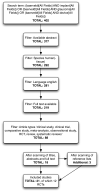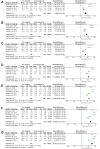The Baerveldt Glaucoma Drainage Device: Efficacy, Safety, and Place in Therapy
- PMID: 33061263
- PMCID: PMC7522304
- DOI: 10.2147/OPTH.S219271
The Baerveldt Glaucoma Drainage Device: Efficacy, Safety, and Place in Therapy
Abstract
Objective: This review summarizes published findings concerning the Baerveldt-350 glaucoma drainage device (GDD). Most studies focus on the comparison between different treatments; in this review, the primary focus is efficacy, safety, and place in therapy for the Baerveldt implant.
Methods: A systematic review was performed using the PubMed database for literature on March 13th, 2020. Efficacy was estimated by performing multiple meta-analyses to calculate the weighted mean difference in intraocular pressure (IOP) and IOP-lowering medication after surgery. In order to get an indication of the safety of the Baerveldt implant, all recorded peri- and postoperative complication were summarized.
Results: A total of 21 studies, including 12 randomized controlled trials, were included with a follow-up up to 5 years, covering a mix of glaucoma types. At the last follow-up point, at 5 years postoperative, the mean (95% confidence interval) reduction in IOP was 15.57 mmHg (14.43-16.71) and the mean (95% confidence interval) reduction in IOP-lowering medication after surgery was 1.81 (1.61-2.01). Most frequently observed postoperative complications were corneal edema (2-34%) and tube complications (4-33%). Rates of required re-intervention ranged from 0% to 51% across all included studies.
Conclusion: The efficacy of the Baerveldt implant is a significant reduction in IOP in the long term. The safety profile of the Baerveldt implant in terms of complication incidence is similar to those reported for other GDD's. For treatment of secondary glaucoma, we suggest the Baerveldt (or any other similar GDD) as the choice of treatment in patients where highest IOP reduction is desired.
Keywords: Baerveldt implant; glaucoma; glaucoma drainage device; intraocular pressure.
© 2020 Poelman et al.
Conflict of interest statement
The authors report no conflicts of interest in this work.
Figures




References
-
- Hertzog LH, Albrecht KG, LaBree L, Lee PP. Glaucoma care and conformance with preferred practice patterns: examination of the private community-based ophthalmologist. Ophthalmol. 1996;103(7):1009–1013. - PubMed
-
- Yadav KS, Sharma S. Implantable drainage devices in glaucoma: quo vadis? Eur J Pharm Sci. 2019;133:1–7. - PubMed
-
- Hodkin MJ, Goldblatt WS, Burgoyne CF, Ball SF, Insler MS. Early clinical experience with the Baerveldt implant in complicated glaucomas. Am J Ophthalmol. 1995;120(1):32–40. - PubMed
-
- Gedde SJ, Feuer WJ, Shi W, et al. Treatment outcomes in the primary tube versus trabeculectomy study after 1 year of follow-up. Graefes Arch Clin Exp Ophthalmol. 2018;125(5):650–663. - PubMed
Publication types
LinkOut - more resources
Full Text Sources

